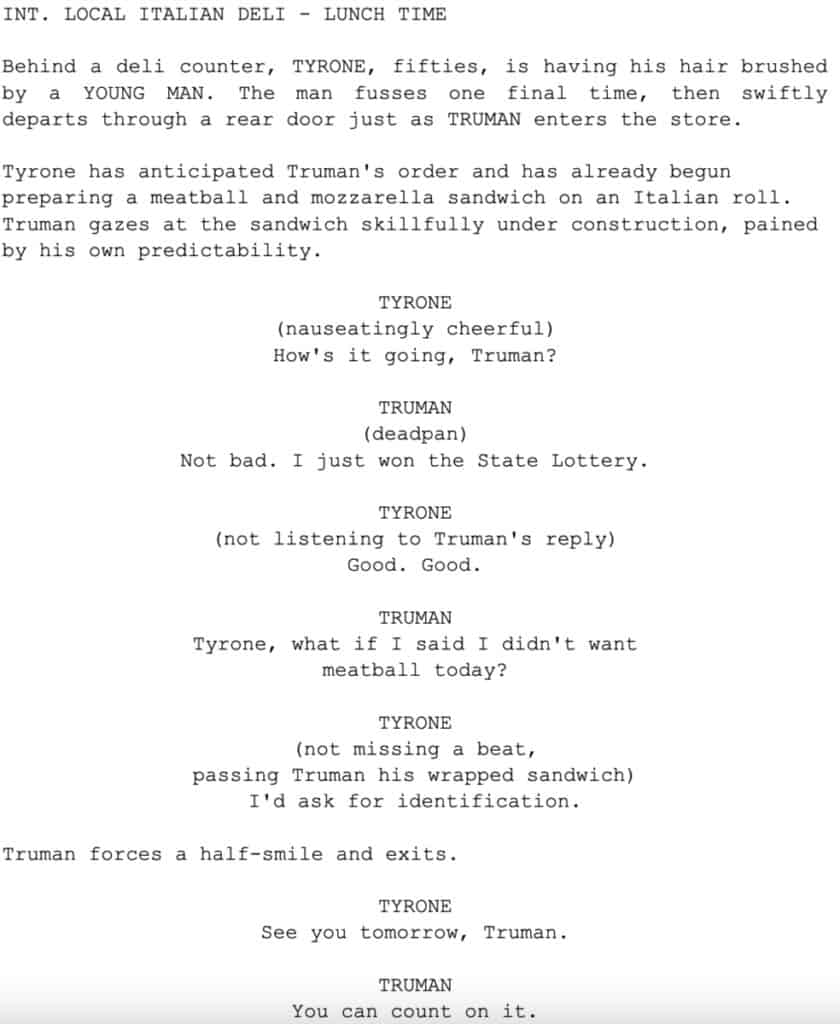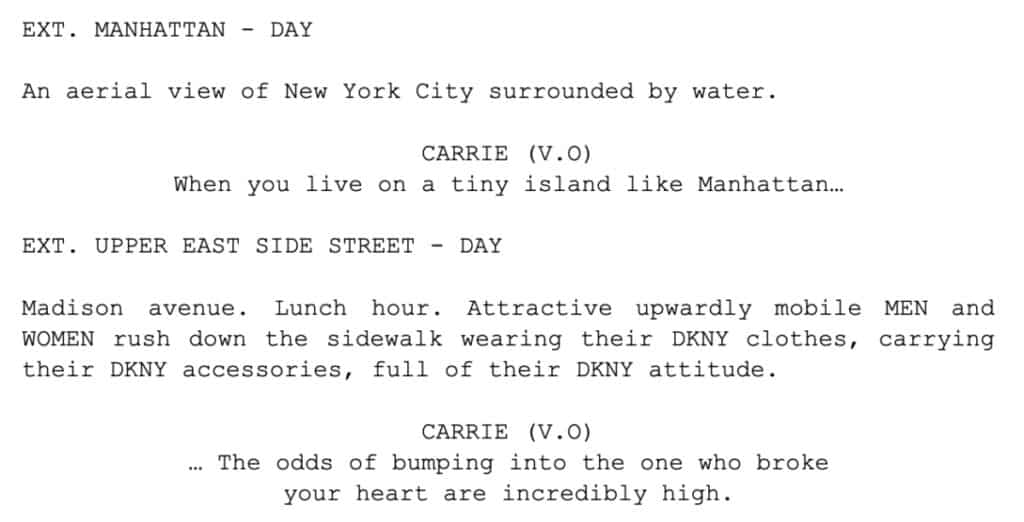Every screenplay comes with a pretty clear and unchangeable format.
There are a lot of things you can be creative with: structure, plot, characters,… but not with format.
Screenplay software have been created purposely to take care of the format of your script, from font to headers and placement of the different actions on the page.
In this article, we will look at every part that makes a script format including the font, the margins, page numbers, scene headings, action lines, dialogue and more.
What Is Formatting?
A script is a document often shared in the form of a PDF that by industry standards ranges from 90 to a 120 pages.
A screenplay is a document with text that has the entirety of what is shown on the screen in it.
As you know from this article on how to read a screenplay, scripts are mostly made of white space.
- Scripts have 12-point Courier font size
- 1.5 inch margin on the left and 1 inch margin on the right
- 1 inch margin on the top and the bottom of the page
- Characters names when prior to a dialogue are typed in ALL CAPS
- Dialogue is always in the middle of the page, 2.5 inches from the left side.
- Page numbers need to be shown on every page aside from the title page… the title page is always different in appearance than the rest of the script.
Sounds overwhelming, does it not?
We sometimes see new writers type the entirety of a script in a Word Document, which is a big mistake. You will lose an insane amount of time trying to get the formatting right.
Instead, let a screenwriting software take care of that part. You can find a list of free and paid screenwriting software here.
Once you are getting started on a screenwriting software, let’s look at the script formatting in details:
The Title Page
Every script starts with a title page.
On the title page, we can obviously find the title of the script, but also the name of the writer(s), the contact(s) of the writer(s) with their email or phone number, which can be replaced with the contact to a rep for represented writers.
Scene Headings
Every scene starts with a scene heading.
For a scene that happens inside, the scene heading might read something such as:

For a scene that happens outside, the scene heading might go:

When breaking up the heading, it always starts with an indication of INT or EXT letting the reader know if the scene takes place inside (interior) or outside (exterior).
It is then followed by a location (house, street, bedroom, park, etc) and the time of day (day or night). It used to be common to have “morning” “afternoon” “dawn” but it’s less and less used in screenplays nowadays.
There are times when a scene is shot from inside a location and outside, for example when the protagonist is driving in a car.
You would write this as:

This lets the reader know that some parts are shown from inside the car, and parts from outside. If the protagonist is driving, you will add a mention saying (MOVING) next to the word “car”, letting us know that the vehicle is in motion.
Action Line
Following every scene heading, you will have an action line, even if short.
Resist the urge to immediately get into dialogue after a scene heading.
While dialogue is often what readers prefer, it takes a truly talented writer to write compelling action lines.
Give a feeling to your action lines, make them colorful, give the reader emotions by using words that depict a clear picture.
For example, in “The Truman Show” writer Andrew M. Nicoll makes an outside scene so vivid:

Now doesn’t this immediately give you the right feeling? It supports the thematics of the movie in only a couple of sentences and makes us feel like we are Truman ourselves walking down that street.
As you can see, an action line is basically a description of what is on the screen, what can be seen by the viewer and what is currently happening in that scene.
Character Introductions
Every great script has compelling characters. Most of the time, these characters are introduced in an entertaining way that makes them easy to remember and understand.
While in a script you cannot usually tell us something we cannot see with our eyes, the character introduction is a part where you can get away with telling us a bit more than what we can see on screen at that time as long as whatever you are saying supports who the character truly is.
An example of that is how Annie is introduced in the movie Misery by William Goldman.

If you’ve seen the movie, you know that this description tells us so much about who Annie turns out to be and it is a really compelling way to introduce a character.
As you can see, her name is written in ALL CAPS, which is always the standard way of introducing a character in a script for their first time on the screen. After that, the character won’t be appearing in all caps anymore.
Many famous storytellers believe firmly that screenplays start with characters versus plot. I must say that I agree with that statement. Your characters struggle and dreams are what make the audience truly relate and engage with your movie.
Every script has different type of characters:
The Protagonist
He or she is the main character in the story. The one who drives the story and whose decisions impact every aspect of the story.
Every scene brings out something new in the protagonist.
He or she connects directly to the themes and is the one who needs to change throughout the story.
The Antagonist
The antagonist is the very opposite of the protagonist. It’s the enemy.
The protagonist and antagonist are directly linked and their actions impact each other.
The antagonist isn’t always a villain (although most of the time they are) but more so someone that believes in the opposite than what the protagonist believes in.
The key to writing a good antagonist is to make them realistic, describe their point of view, give them reasons for their behavior and remember that in their origin story, the villain is the protagonist (The Joker is an antagonist in Batman, but a protagonist in the movie The Joker).
Remembering this puts things into perspective when creating antagonists that are compelling.
Supporting Characters
All screenplays and stories (or at least most) have a supporting character or supporting characters. They can come in the form of allies to the protagonists, mentors to the protagonist (such as in Star Wars or The Karate Kid), a romantic interest, jokesters that will test and challenge the protagonist, or people that will teach the protagonist a lesson by betraying them one way or another.
Dialogue
One of the most important aspects of your script is your character’s dialogue.
Dialogue appears under the character’s name in a script. If we go back to The Truman Show, here’s an example of a scene with dialogue.

So much is implied in this scene and so much is subtext. It tells us so much about Truman’s current state of mind and how everyone else in this world follows the motion.
We don’t need words from Truman that say “we have no choice in this world,” his “what if I told you I didn’t want meatball today?” says it all.
It’s a brilliant way to craft dialogue and keep it implied.
As far as the placement of the dialogue, you can see that it is right under the character’s name in the middle of the page.
This scene also uses a lot of parentheticals. Another important part of formatting.
When something needs to be explained, for example when a character is sarcastic, coughs, or does a short action while speaking, it needs to be mentioned in a parenthetical as seen in this scene.
Another important aspect of formatting is the use of Voice Over or Off Screen dialogue.
When a character is not seen on screen when saying their lines (on the phone or from another room), we use O.S (Off Screen) next to their name. For example:

When a character narrates a story such as in Sex and the City, this is what it looks like in “Take Me Out to the Ballgame” (episode 1, season 2).

The difference between O.S and V.O is that one has a character present in the scene but not on screen and the other is a narrator who might never appear in the story at all.
These are the main aspects of formatting your screenplay. The best way to get more comfortable with formatting is to read plenty of screenplays. We recommend downloading well-known screenplays from websites such as Script PDF or Simply Scripts.
Additionally, we advise every writer to also read unproduced screenplays such as the ones from The Black List or The Hit List.
Now that you know the ins and outs of formatting, let’s get writing!
